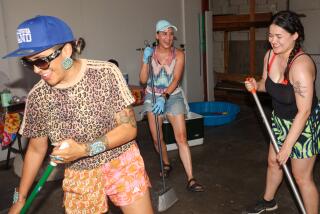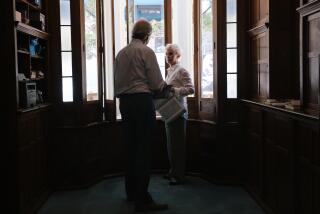Mixed Blessings : Missionaries’ Efforts Raise Troubling Issues for Navajos
- Share via
PORCUPINE MESA, Ariz. — It was only 9:30 a.m. on this high-desert plain but Hans Benning and his crew of believers had been pouring sweat for five hours, laboring on a shelter for a small congregation of Navajo Christians.
It was their fourth day of work when Benning lost his footing and landed hard on his backside while clambering across the shelter’s partly built roof. But the 49-year-old Studio City man, who already was concealing a broken hand, barely paused. Caught up in the urgency of the mission, he shook off the pain and continued working.
“We needed to get the job done,” Benning said later.
The strength of Benning’s 35-year obsession with American Indians in general and the Navajos in particular inspired 28 members of the Osborne Neighborhood Church in the San Fernando Valley community of Arleta to join him in the desert of northern Arizona for a week of dawn-to-dark work under a fierce sun and an impossibly blue sky.
Undaunted by 95-degree temperatures and gusts of stinging red sand, the group built a traditional pine and juniper structure known as a brush arbor, conducted a Bible school for local children and added a room to the Porcupine Mesa Baptist Church.
But Benning acknowledged that his crew, who ranged in age from 9 to 69, faced an even more difficult challenge than the ones posed by hammer, nails, mortar and weather.
The group had to overcome the legacy of hundreds of years of mistreatment by white men, especially Christian missionaries, he said.
Critics say the Navajo way of life is threatened by the influences of modern American life and that such Christian evangelism, though well-intentioned, further undermines the culture.
Studio City writer Raymond Friday Locke, who wrote the authoritative history, “The Book of the Navajo,” said missionaries who seek to convert American Indians to Christianity do more harm than good, setting them loose from their cultural moorings with potentially harmful consequences.
“As far as I’m concerned . . . all they do is create more drunks,” Locke said. “They confuse the Navajo. They try to get them to give up their religion . . . and then they have no place in either society.”
Acknowledging those criticisms, Benning said: “In the name of Christianity, horrible atrocities have been done. My main goal is to show them a different kind of white people.”
Even though they built a church and offered Bible classes, Benning said achieving conversions was not a priority.
“We’re not there to hit them over the head with Bibles or tell them they’re going to hell,” said Benning, a violin and cello maker. “I cannot convert anybody. That’s God’s business. I can only show them by my actions and behavior and my people’s behavior that Christianity works for me.”
Benning is a member of the Arleta church and vice president of the Los Angeles-based American Indian Liberation Crusade. The church has supported Benning and the crusade for the past five years, with Benning and other church members traveling to reservations in several Southwestern states an average of once a month.
The crusade, which raises money with a radio program called the “American Indian Hour,” also provides partial financial support for seven churches with Navajo pastors--including the one at Porcupine Mesa. In addition, the organization provides Christmas food baskets for hundreds of Christian and non-Christian families, sends children to Bible camp and, led by Benning, builds churches.
The Porcupine Mesa Baptist Church is eight miles down a dirt road off U.S. Highway 89A. It is in an area of the Navajo nation that has no telephones, indoor plumbing or electricity even though it is only 45 minutes by car from the modern, growing city of Page and the huge Glen Canyon Dam at Lake Powell.
The 600 residents of the community live in isolated camps of one or more houses, either traditional round hogans or cinder-block or wood-frame rectangles.
The area is one of the poorest on the poverty-stricken reservation, which is about the size of West Virginia. Families must travel to Page to fetch water in barrels when the few balky, wind-powered wells break down.
Because of its isolation, the area is also a stronghold of traditional beliefs. About 75% of the adults speak only Navajo. Although Christianity is widely accepted in other parts of the reservation, the church still generates suspicion.
The church at Porcupine Mesa has only about 30 regular attendees, all of whom are close relatives of Jeanne Mexicano, whose husband, Jimmy, is the church’s pastor.
Jimmy Mexicano studied at Navajo Bible College in Colorado and began preaching about a decade ago in his small concrete-block house. A one-room stucco church was built nearby about four years ago and the Arleta group’s goal was to insulate, rewire and drywall that structure and to build an addition to serve as a children’s room. As a finishing touch, they mounted a bell Benning had found to summon the faithful to worship.
Working side by side with several Navajos, the men--who included several engineers, a retired fire captain, an attorney and a car mechanic--worked 15-hour days roofing, pouring concrete, framing walls and wiring for generator-powered electricity.
The women cooked meals and conducted Bible school classes for about 40 children. The youths in the group helped with the classes, provided musical accompaniment with guitars and violins, organized recreation and pitched in at the construction site.
The group used pit toilets and makeshift showers. They ate meals under a large canvas tent. At night they slept in tents dusted inside and out with fine red sand, beneath a sky brilliantly lit by the sweep of the Milky Way.
“When you see something like that, how can you deny the existence of God?” asked Rachel Martinez, a community liaison for Montague Elementary School in Pacoima.
But Navajo critics say they have their own explanation of the heavens and disdain missionaries who would force them to accept the tenets of Christian faith.
Harry Walters, who chairs the Dineh (Navajo) Studies Department at Navajo Community College in Tsaile, Ariz., is skeptical of all missionaries, including those from the Arleta church.
“That kind of help I don’t call help,” he said. “The Navajo culture is still strong, the Navajos do not need any religion. The one they have has served the Navajo nation very well.”
In addition, Christians have been involved in efforts over the past 100 or more years to wipe out the Indian culture and language, especially through schools they established. Even Pope John Paul II acknowledged the cultural insensitivity of the church’s legacy during his U.S. visit this month when he decried the destruction of sacred objects and said that now “the church contemplates your authentic values with love and hope.”
Studio City author Locke said it took decades for Christian missionaries to realize that the Navajos had a spiritual life.
The essence of Navajo beliefs springs from the idea that the universe is composed of four elements--fire, earth, air and water--said Walters, an anthropologist. There are numerous ceremonies--called “ways” or “sings”--to restore the balance among the elements when they have been upset by witchcraft or an individual’s misdeeds.
Most missionaries today say that many of those ceremonies can be incorporated into Christian worship, making it possible to be both Navajo and Christian.
Father Martan Rademaker is director of the 100-year-old Franciscan Mission Center at St. Michael’s Catholic Mission near Window Rock, Ariz. That church conducts Masses in the Navajo language and has adapted prayers from some of the ceremonies, including the Blessing Way, one of the most important in Navajo life.
“My basic approach . . . is to try to encourage Navajo people to look at their traditional practices as their Old Testament, the way the Jewish tradition is our Old Testament,” he said.
The number of Christian churches on the reservation has exploded from fewer than 50 to more than 400 in the past several decades, according to Ted Dolaghan, director of the Navajo Gospel Mission in Flagstaff. He estimates that 20% of the 220,000 Navajos on the reservation are Christian.
But the mistrust between Christians and traditional Navajos remains strong in Porcupine Mesa. Membership is also strong there in the 100-year-old Native American Church, which combines Christianity, traditional Navajo beliefs and the use of peyote cactus, a powerful hallucinogenic drug.
“We’re not against them,” Jimmy Mexicano said of his non-Christian neighbors. “But we tell them the truth and the Word of God. . . . Maybe someday they will change their minds and know that Christianity is the truth.”
Katy Spencer, who is Mexicano’s sister-in-law, said members of her family who are Christian are now cut off from their neighbors. Even non-believing relatives stopped associating with the Spencers until recently.
Spencer, a trained social worker who has lived in San Francisco and Phoenix, said that unlike many of the residents of Porcupine Mesa, she believes it is possible to embrace both Christianity and the Navajo culture.
To illustrate, she said the 200-foot-high mesa that gives the area its name is sacred to Navajos, who still visit it to commune with the gods believed to reside there. But now, Christians also climb the mesa’s well-worn trail to pray.
Joyce Millikan, a Shadow Hills dental hygienist who organized most of the meals for the week, blamed missionaries for the Navajos’ distrust of Christians such as herself.
“In their self righteousness they have . . . imposed Western culture not only on Navajos but on a lot of other cultures,” she said. “But knowing what we know today we need to accept people the way they are, even if they are not like us.”
On Friday, the last day of Bible school, Hans Benning paused long enough from his work to address the Navajo children and sum up his motivations.
“I just want to leave you with one thing,” he said. “We love you. We love you and we want to see God’s blessing on you.”
More to Read
Sign up for Essential California
The most important California stories and recommendations in your inbox every morning.
You may occasionally receive promotional content from the Los Angeles Times.










